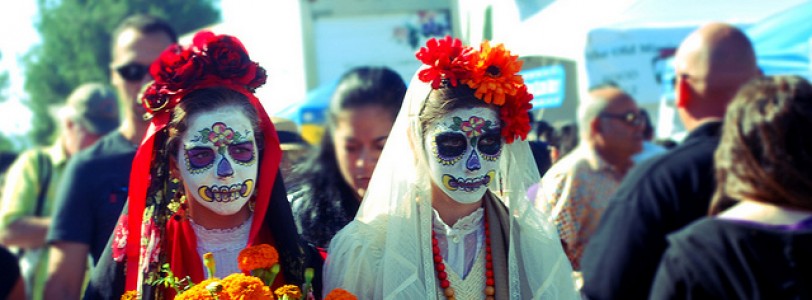Dia de los Muertos is a Mexican festival, coinciding with Halloween. The Day of the Dead combines many traditions, old and new, for a week of festivities to celebrate the deceased.
The basis of the festival originates from the belief that during the week, those dead are given free passage into the world of the living, enabling them to enjoy the riches of this world. The Days of the Dead begin on the 31st October, with families, friends and communities all coming together to 'welcome' their ancestors back into the world of the living. This is often done with lavish sweet foods, and brightly coloured decorations, highlighting the happiness and celebration, as opposed to the more sombre approach often taken in western society.
The living decorate graves of loved ones. Baked and crafted goods subsequently adorn those markings of passing, lighting up the county and enabling frank and spiritual talk to occur. Running parallel with Halloween, many children are encouraged to dress up as the dead, with skeletons proving a popular choice. The celebration peaks on the 1st, (Dia de los Inocentes) and 2nd (Dia de los Muertos), of November with parades and fares cropping up not only all over Mexico, but the UK now too.
The international links celebrate the growing Spanish and Mexican communities throughout the UK, often with student exchanges. The social and celebratory nature of the Latin American holiday is particularly prevalent this year in Bristol, with the Festival of the Dead - an 18+ 'halloween fiesta like no other'.
Symbolism forms an inherent part of this holiday, with La Calavera Catrina, (The Elegant Skull), a recognised embodiment of traditional imagery. She has even found her way into contemporary fashion, with the figure being cast in gold, as a necklace, or even printed onto silk scarves. Other archetypical symbolism includes the Calavera, simply translating to 'Skull'. The iconography of the skull during the festival makes it a common standard for face painting, and even jewellery. Sugar skulls are markers of the festivities too, decorating altars, graves, sweet shop windows and tables; they seem to be popular with both the living and the dead.
Artist influences are obvious with of course Frida Kahlo coming to mind. This Mexican feminist, revolutionary and painter worked right up until her death in 1954 and embodied her culture through colour, fashion, texture and politics. Her life and artwork are explicitly recognised today with tributes throughout Mexico and indeed internationally. It could also be argued that the more recent and perhaps morbid works of Damien Hirst have drawn influence from Día de los Muertos, as may be the case for his predominantly lavish, diamond encrusted skulls.
This article was updated for accuracy 31st October 2016









0 Comments